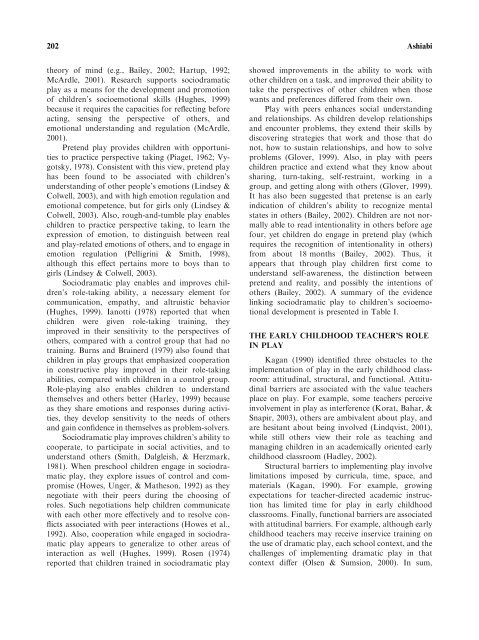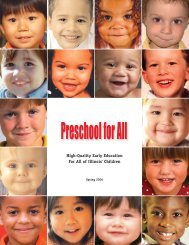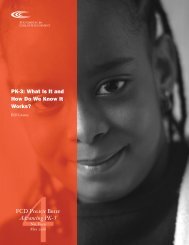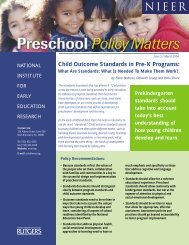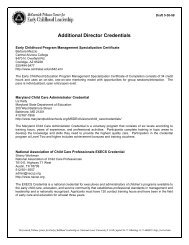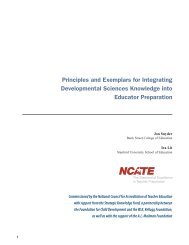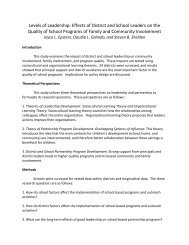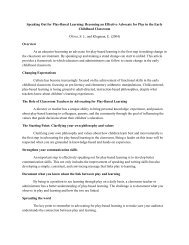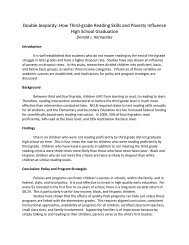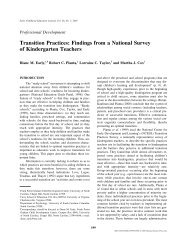Play in the Preschool Classroom - Leadership to INtegrate the Early ...
Play in the Preschool Classroom - Leadership to INtegrate the Early ...
Play in the Preschool Classroom - Leadership to INtegrate the Early ...
Create successful ePaper yourself
Turn your PDF publications into a flip-book with our unique Google optimized e-Paper software.
202 Ashiabi<br />
<strong>the</strong>ory of m<strong>in</strong>d (e.g., Bailey, 2002; Hartup, 1992;<br />
McArdle, 2001). Research supports sociodramatic<br />
play as a means for <strong>the</strong> development and promotion<br />
of children’s socioemotional skills (Hughes, 1999)<br />
because it requires <strong>the</strong> capacities for reflect<strong>in</strong>g before<br />
act<strong>in</strong>g, sens<strong>in</strong>g <strong>the</strong> perspective of o<strong>the</strong>rs, and<br />
emotional understand<strong>in</strong>g and regulation (McArdle,<br />
2001).<br />
Pretend play provides children with opportunities<br />
<strong>to</strong> practice perspective tak<strong>in</strong>g (Piaget, 1962; Vygotsky,<br />
1978). Consistent with this view, pretend play<br />
has been found <strong>to</strong> be associated with children’s<br />
understand<strong>in</strong>g of o<strong>the</strong>r people’s emotions (L<strong>in</strong>dsey &<br />
Colwell, 2003), and with high emotion regulation and<br />
emotional competence, but for girls only (L<strong>in</strong>dsey &<br />
Colwell, 2003). Also, rough-and-tumble play enables<br />
children <strong>to</strong> practice perspective tak<strong>in</strong>g, <strong>to</strong> learn <strong>the</strong><br />
expression of emotion, <strong>to</strong> dist<strong>in</strong>guish between real<br />
and play-related emotions of o<strong>the</strong>rs, and <strong>to</strong> engage <strong>in</strong><br />
emotion regulation (Pelligr<strong>in</strong>i & Smith, 1998),<br />
although this effect perta<strong>in</strong>s more <strong>to</strong> boys than <strong>to</strong><br />
girls (L<strong>in</strong>dsey & Colwell, 2003).<br />
Sociodramatic play enables and improves children’s<br />
role-tak<strong>in</strong>g ability, a necessary element for<br />
communication, empathy, and altruistic behavior<br />
(Hughes, 1999). Ianotti (1978) reported that when<br />
children were given role-tak<strong>in</strong>g tra<strong>in</strong><strong>in</strong>g, <strong>the</strong>y<br />
improved <strong>in</strong> <strong>the</strong>ir sensitivity <strong>to</strong> <strong>the</strong> perspectives of<br />
o<strong>the</strong>rs, compared with a control group that had no<br />
tra<strong>in</strong><strong>in</strong>g. Burns and Bra<strong>in</strong>erd (1979) also found that<br />
children <strong>in</strong> play groups that emphasized cooperation<br />
<strong>in</strong> constructive play improved <strong>in</strong> <strong>the</strong>ir role-tak<strong>in</strong>g<br />
abilities, compared with children <strong>in</strong> a control group.<br />
Role-play<strong>in</strong>g also enables children <strong>to</strong> understand<br />
<strong>the</strong>mselves and o<strong>the</strong>rs better (Harley, 1999) because<br />
as <strong>the</strong>y share emotions and responses dur<strong>in</strong>g activities,<br />
<strong>the</strong>y develop sensitivity <strong>to</strong> <strong>the</strong> needs of o<strong>the</strong>rs<br />
and ga<strong>in</strong> confidence <strong>in</strong> <strong>the</strong>mselves as problem-solvers.<br />
Sociodramatic play improves children’s ability <strong>to</strong><br />
cooperate, <strong>to</strong> participate <strong>in</strong> social activities, and <strong>to</strong><br />
understand o<strong>the</strong>rs (Smith, Dalgleish, & Herzmark,<br />
1981). When preschool children engage <strong>in</strong> sociodramatic<br />
play, <strong>the</strong>y explore issues of control and compromise<br />
(Howes, Unger, & Ma<strong>the</strong>son, 1992) as <strong>the</strong>y<br />
negotiate with <strong>the</strong>ir peers dur<strong>in</strong>g <strong>the</strong> choos<strong>in</strong>g of<br />
roles. Such negotiations help children communicate<br />
with each o<strong>the</strong>r more effectively and <strong>to</strong> resolve conflicts<br />
associated with peer <strong>in</strong>teractions (Howes et al.,<br />
1992). Also, cooperation while engaged <strong>in</strong> sociodramatic<br />
play appears <strong>to</strong> generalize <strong>to</strong> o<strong>the</strong>r areas of<br />
<strong>in</strong>teraction as well (Hughes, 1999). Rosen (1974)<br />
reported that children tra<strong>in</strong>ed <strong>in</strong> sociodramatic play<br />
showed improvements <strong>in</strong> <strong>the</strong> ability <strong>to</strong> work with<br />
o<strong>the</strong>r children on a task, and improved <strong>the</strong>ir ability <strong>to</strong><br />
take <strong>the</strong> perspectives of o<strong>the</strong>r children when those<br />
wants and preferences differed from <strong>the</strong>ir own.<br />
<strong>Play</strong> with peers enhances social understand<strong>in</strong>g<br />
and relationships. As children develop relationships<br />
and encounter problems, <strong>the</strong>y extend <strong>the</strong>ir skills by<br />
discover<strong>in</strong>g strategies that work and those that do<br />
not, how <strong>to</strong> susta<strong>in</strong> relationships, and how <strong>to</strong> solve<br />
problems (Glover, 1999). Also, <strong>in</strong> play with peers<br />
children practice and extend what <strong>the</strong>y know about<br />
shar<strong>in</strong>g, turn-tak<strong>in</strong>g, self-restra<strong>in</strong>t, work<strong>in</strong>g <strong>in</strong> a<br />
group, and gett<strong>in</strong>g along with o<strong>the</strong>rs (Glover, 1999).<br />
It has also been suggested that pretense is an early<br />
<strong>in</strong>dication of children’s ability <strong>to</strong> recognize mental<br />
states <strong>in</strong> o<strong>the</strong>rs (Bailey, 2002). Children are not normally<br />
able <strong>to</strong> read <strong>in</strong>tentionality <strong>in</strong> o<strong>the</strong>rs before age<br />
four, yet children do engage <strong>in</strong> pretend play (which<br />
requires <strong>the</strong> recognition of <strong>in</strong>tentionality <strong>in</strong> o<strong>the</strong>rs)<br />
from about 18 months (Bailey, 2002). Thus, it<br />
appears that through play children first come <strong>to</strong><br />
understand self-awareness, <strong>the</strong> dist<strong>in</strong>ction between<br />
pretend and reality, and possibly <strong>the</strong> <strong>in</strong>tentions of<br />
o<strong>the</strong>rs (Bailey, 2002). A summary of <strong>the</strong> evidence<br />
l<strong>in</strong>k<strong>in</strong>g sociodramatic play <strong>to</strong> children’s socioemotional<br />
development is presented <strong>in</strong> Table I.<br />
THE EARLY CHILDHOOD TEACHER’S ROLE<br />
IN PLAY<br />
Kagan (1990) identified three obstacles <strong>to</strong> <strong>the</strong><br />
implementation of play <strong>in</strong> <strong>the</strong> early childhood classroom:<br />
attitud<strong>in</strong>al, structural, and functional. Attitud<strong>in</strong>al<br />
barriers are associated with <strong>the</strong> value teachers<br />
place on play. For example, some teachers perceive<br />
<strong>in</strong>volvement <strong>in</strong> play as <strong>in</strong>terference (Korat, Bahar, &<br />
Snapir, 2003), o<strong>the</strong>rs are ambivalent about play, and<br />
are hesitant about be<strong>in</strong>g <strong>in</strong>volved (L<strong>in</strong>dqvist, 2001),<br />
while still o<strong>the</strong>rs view <strong>the</strong>ir role as teach<strong>in</strong>g and<br />
manag<strong>in</strong>g children <strong>in</strong> an academically oriented early<br />
childhood classroom (Hadley, 2002).<br />
Structural barriers <strong>to</strong> implement<strong>in</strong>g play <strong>in</strong>volve<br />
limitations imposed by curricula, time, space, and<br />
materials (Kagan, 1990). For example, grow<strong>in</strong>g<br />
expectations for teacher-directed academic <strong>in</strong>struction<br />
has limited time for play <strong>in</strong> early childhood<br />
classrooms. F<strong>in</strong>ally, functional barriers are associated<br />
with attitud<strong>in</strong>al barriers. For example, although early<br />
childhood teachers may receive <strong>in</strong>service tra<strong>in</strong><strong>in</strong>g on<br />
<strong>the</strong> use of dramatic play, each school context, and <strong>the</strong><br />
challenges of implement<strong>in</strong>g dramatic play <strong>in</strong> that<br />
context differ (Olsen & Sumsion, 2000). In sum,


